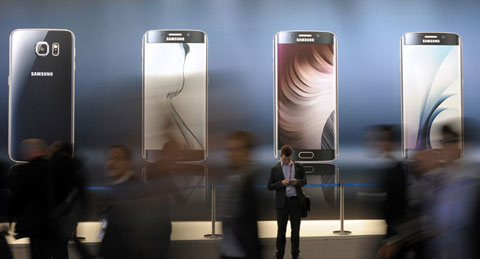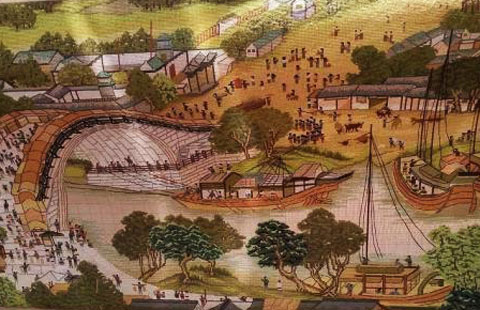Pieces of pilot's life came together for pioneering project
Updated: 2015-04-17 07:16
By Tan Yingzi in Chongqing(China Daily)
|
||||||||
Every part of Andre Borschberg's life is like a piece of a puzzle that fits together to form the larger picture of Solar Impulse 2, the solar-powered aircraft that promotes sustainable development.

The 62-year-old former Swiss fighter pilot, engineer and entrepreneur, dressed in a black T-shirt, looked fit and confident before his flight from Chongqing to Nanjing.
The seventh leg of the journey will see the greatest test of the aircraft and its pilots, flying at least five days and nights over the Pacific Ocean to Hawaii.
"It will be the most challenging part of our global journey," he said. "It has never been done before, and we don't know if the airplane or the pilot is capable of doing this."
He and his fellow pilot, Bertrand Piccard, are making history flying the Swiss-developed Solar Impulse 2 aircraft around the world, day and night. The pair take turns flying the single-seater aircraft - which is made from carbon fiber and has 17,248 solar cells built into its wings - 35,000 kilometers over 12 legs. The journey started in Abu Dhabi on March 9 and is scheduled to take five months.
Passionate about aviation since childhood, Borschberg trained as a jet pilot and flew with the Swiss air force for 20 years.
With degrees in both engineering and management, he set up his own technology businesses before he met Piccard through the Swiss Federal Institute of Technology in Lausanne in 2003.
After ballooning around the world in 1999, Piccard had the idea to travel globally with no fuel. The institute invited Borschberg to conduct the feasibility study.
"We got along very well and decided to launch the project together in November 2003," he said.
As the CEO of Solar Impulse, Borschberg turns the vision of sustainable development into reality with his skills in aviation, engineering and management.
Their first prototype aircraft, Solar Impulse 1, had its first test flight in December 2009. Piccard and Borschberg completed successful solar-powered flights from Switzerland to Spain and then to Morocco in 2012. In 2013, they co-piloted a multistop flight across the United States. The upgraded Solar Impulse 2 was built last year.
The two men's different personalities and backgrounds form an interesting partnership that is the key to the success of the project, according to Borschberg.
"We are very different, but we are very complementary," he said. "We share the same passion, vision and values."
Although they disagree on many issues, they always find a third way to solve the problem.
"Only by working together can we have the better solution," he said.
Catching up
Borschberg, who has visited China 10 times, has found Chinese people have a great interest in clean technology but may not understand it fully.
China has led the world in the production and use of renewable energy, such as wind and solar power.
"What we advocate through the airplane is not the use of renewable energy, but the importance of using technologies to be more energy-efficient," he said. "Chinese people may not be aware of the full potential of clean technologies and the possibilities they offer."
However, Borschberg is confident that China can catch up soon.
Borschberg puts his beliefs into practice. He has owned a hybrid car for 10 years, and his house is energy-efficient.
His wife, Yasmin, has traveled with the ground support team and handles public relations.
"The whole family was excited when we first heard about the project," she said. "There is a degree of unknown about crossing the oceans, but I am not worried. The project has been carefully prepared."

 Top 10 foreign holders of US Treasuries
Top 10 foreign holders of US Treasuries
 Denmark's Queen Margrethe 75th birthday celebrated
Denmark's Queen Margrethe 75th birthday celebrated
 Lost in sandstorms
Lost in sandstorms
 New roles for technology: Rise of robots
New roles for technology: Rise of robots
 Strange but true: Getting ahead of the rest
Strange but true: Getting ahead of the rest
 Top 10 industries with most job-hoppers
Top 10 industries with most job-hoppers
 Russia honors Chinese veterans from WWII
Russia honors Chinese veterans from WWII
 Woman embroiders giant painting
Woman embroiders giant painting
Most Viewed
Editor's Picks

|

|

|

|

|

|
Today's Top News
World Bank, IMF: will work with AIIB
Ex-PM says US, China can be allies
Carrying on a Chinese food legacy
America, Europe told to work with BRICS
Beijing film festival draws top moviemakers, Oscar winners
Chinese teachers mark progress
US-listed Chinese tech stocks not bubbly: analysts
AIIB praised, US criticized by experts
US Weekly

|

|






